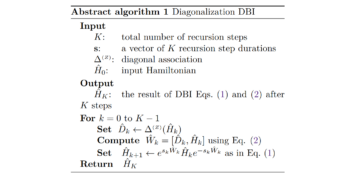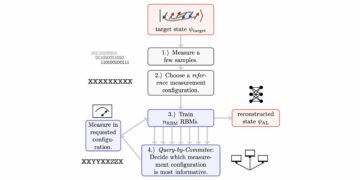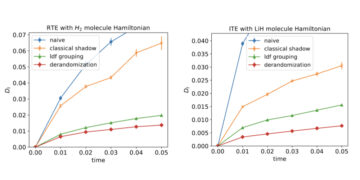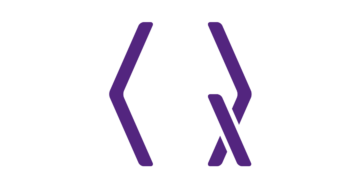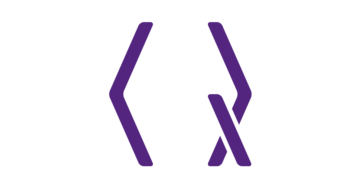1SUPA, School of Physics and Astronomy, University of St Andrews, St Andrews KY16 9SS, United Kingdom
2School of Mathematics and Physics, The University of Queensland, St Lucia, Queensland 4072, Australia
3Department of Physics and SUPA, University of Strathclyde, Glasgow G4 0NG, United Kingdom
Find this paper interesting or want to discuss? Scite or leave a comment on SciRate.
Abstract
Tracing out the environmental degrees of freedom is a necessary procedure when simulating open quantum systems. While being an essential step in deriving a tractable master equation it represents a loss of information. In situations where there is strong interplay between the system and environmental degrees of freedom this loss makes understanding the dynamics challenging. These dynamics, when viewed in isolation, have no time-local description: they are non-Markovian and memory effects induce complex features that are difficult to interpret. To address this problem, we here show how to use system correlations, calculated by any method, to infer any correlation function of a Gaussian environment, so long as the coupling between system and environment is linear. This not only allows reconstruction of the full dynamics of both system and environment, but also opens avenues into studying the effect of a system on its environment. In order to obtain accurate bath dynamics, we exploit a numerically exact approach to simulating the system dynamics, which is based on the construction and contraction of a tensor network that represents the process tensor of this open quantum system. Using this we are able to find any system correlation function exactly. To demonstrate the applicability of our method we show how heat moves between different modes of a bosonic bath when coupled to a two-level system that is subject to an off-resonant drive.
► BibTeX data
► References
[1] H. P. Breuerand F. Petruccione “The Theory of Open Quantum Systems” Oxford University Press (2002).
[2] A. W. Chin, J. Prior, R. Rosenbach, F. Caycedo-Soler, S. F. Huelga, and M. B. Plenio, “The role of non-equilibrium vibrational structures in electronic coherence and recoherence in pigment–protein complexes” Nat. Phy. 9, 113–118 (2013).
https://doi.org/10.1038/nphys2515
[3] M. Thorwart, J. Eckel, J.H. Reina, P. Nalbach, and S. Weiss, “Enhanced quantum entanglement in the non-Markovian dynamics of biomolecular excitons” Chem. Phys. Lett. 478, 234–237 (2009).
https://doi.org/10.1016/j.cplett.2009.07.053
[4] M. Mohseni, A. Shabani, S. Lloyd, and H. Rabitz, “Energy-scales convergence for optimal and robust quantum transport in photosynthetic complexes” J. Chem. Phys. 140, 035102 (2014).
https://doi.org/10.1063/1.4856795
[5] Marco del Rey, Alex W. Chin, Susana F. Huelga, and Martin B. Plenio, “Exploiting Structured Environments for Efficient Energy Transfer: The Phonon Antenna Mechanism” J. Phys. Chem. Lett. 4, 903–907 (2013).
https://doi.org/10.1021/jz400058a
[6] Christine Maier, Tiff Brydges, Petar Jurcevic, Nils Trautmann, Cornelius Hempel, Ben P. Lanyon, Philipp Hauke, Rainer Blatt, and Christian F. Roos, “Environment-Assisted Quantum Transport in a 10-qubit Network” Phys. Rev. Lett. 122, 050501 (2019).
https://doi.org/10.1103/PhysRevLett.122.050501
[7] Dvira Segaland Bijay Kumar Agarwalla “Vibrational Heat Transport in Molecular Junctions” Ann. Rev. Phys. Chem. 67, 185–209 (2016).
https://doi.org/10.1146/annurev-physchem-040215-112103
[8] S. Gröblacher, A. Trubarov, N. Prigge, G. D. Cole, M. Aspelmeyer, and J. Eisert, “Observation of non-Markovian micromechanical Brownian motion” Nat. Commun. 6, 7606 (2015).
https://doi.org/10.1038/ncomms8606
[9] Anton Potočnik, Arno Bargerbos, Florian A. Y. N. Schröder, Saeed A. Khan, Michele C. Collodo, Simone Gasparinetti, Yves Salathé, Celestino Creatore, Christopher Eichler, Hakan E. Türeci, Alex W. Chin, and Andreas Wallraff, “Studying light-harvesting models with superconducting circuits” Nat. Commun. 9, 904 (2018).
https://doi.org/10.1038/s41467-018-03312-x
[10] Heng-Na Xiong, Yi Li, Yixiao Huang, and Zichun Le, “Photonic Crystal with Infinite Cavity-array Structure” Quant. Inf. & Comp. 18, 267–284 (2018).
https://doi.org/10.26421/QIC18.3-4-6
[11] Inés de Vegaand Daniel Alonso “Dynamics of non-Markovian open quantum systems” Rev. Mod. Phys. 89, 015001 (2017).
https://doi.org/10.1103/revmodphys.89.015001
[12] H. P. Breuer, E. M. Laine, J. Piilo, and B. Vacchini, “Colloquium: Non-Markovian dynamics in open quantum systems” Rev. Mod. Phys. 88, 021002 (2016).
https://doi.org/10.1103/RevModPhys.88.021002
[13] Mark T Mitchison “Quantum thermal absorption machines: refrigerators, engines and clocks” Contemp. Phys. 60, 164–187 (2019).
https://doi.org/10.1080/00107514.2019.1631555
[14] F. Binder, L. A. Correa, C. Gogolin, J. Anders, and G. Adesso, “Thermodynamics in the Quantum Regime” Springer, Cham (2018).
https://doi.org/10.1007/978-3-319-99046-0
[15] M. Brenes, J. J. Mendoza-Arenas, A. Purkayastha, M. T. Mitchison, S. R. Clark, and J. Goold, “Tensor-Network Method to Simulate Strongly Interacting Quantum Thermal Machines” Phys. Rev. X 10, 031040 (2020).
https://doi.org/10.1103/PhysRevX.10.031040
[16] Philipp Strasberg, Gernot Schaller, Neill Lambert, and Tobias Brandes, “Nonequilibrium thermodynamics in the strong coupling and non-Markovian regime based on a reaction coordinate mapping” New J. Phys. 18, 073007 (2016).
https://doi.org/10.1088/1367-2630/18/7/073007
[17] Gerald D Mahan “Many-particle physics” Springer Science & Business Media (2013).
[18] Robert Silbeyand Robert A. Harris “Variational calculation of the dynamics of a two level system interacting with a bath” J. Chem. Phys. 80, 2615–2617 (1984).
https://doi.org/10.1063/1.447055
[19] R. A. Harrisand R. Silbey “Variational calculation of the tunneling system interacting with a heat bath. II. Dynamics of an asymmetric tunneling system” J. Chem. Phys. 83, 1069–1074 (1985).
https://doi.org/10.1063/1.449469
[20] Jozef T Devreeseand Alexandre S Alexandrov “Fröhlich polaron and bipolaron: recent developments” Rep. Prog. Phys. 72, 066501 (2009).
https://doi.org/10.1088/0034-4885/72/6/066501
[21] Alexey Kavokinand Guillaume Malpuech “Cavity polaritons” Elsevier (2003).
[22] Peter Kirtonand Jonathan Keeling “Superradiant and lasing states in driven-dissipative Dicke models” New J. Phys. 20, 015009 (2018).
https://doi.org/10.1088/1367-2630/aaa11d
[23] Alicia J Kollár, Alexander T Papageorge, Varun D Vaidya, Yudan Guo, Jonathan Keeling, and Benjamin L Lev, “Supermode-density-wave-polariton condensation with a Bose–Einstein condensate in a multimode cavity” Nat. Commun. 8, 14386 (2017).
https://doi.org/10.1038/ncomms14386
[24] Martin Gärttner, Justin G Bohnet, Arghavan Safavi-Naini, Michael L Wall, John J Bollinger, and Ana Maria Rey, “Measuring out-of-time-order correlations and multiple quantum spectra in a trapped-ion quantum magnet” Nat. Phy. 13, 781–786 (2017).
https://doi.org/10.1038/nphys4119
[25] Jun Li, Ruihua Fan, Hengyan Wang, Bingtian Ye, Bei Zeng, Hui Zhai, Xinhua Peng, and Jiangfeng Du, “Measuring out-of-time-order correlators on a nuclear magnetic resonance quantum simulator” Phys. Rev. X 7, 031011 (2017).
https://doi.org/10.1103/PhysRevX.7.031011
[26] Mohamad Niknam, Lea F. Santos, and David G. Cory, “Sensitivity of quantum information to environment perturbations measured with a nonlocal out-of-time-order correlation function” Phys. Rev. Res. 2, 013200 (2020).
https://doi.org/10.1103/PhysRevResearch.2.013200
[27] Jake Iles-Smith, Neill Lambert, and Ahsan Nazir, “Environmental dynamics, correlations, and the emergence of noncanonical equilibrium states in open quantum systems” Phys. Rev. A 90, 032114 (2014).
https://doi.org/10.1103/physreva.90.032114
[28] Jake Iles-Smith, Arend G. Dijkstra, Neill Lambert, and Ahsan Nazir, “Energy transfer in structured and unstructured environments: Master equations beyond the Born-Markov approximations” J. Chem. Phys. 144, 044110 (2016).
https://doi.org/10.1063/1.4940218
[29] Neill Lambert, Shahnawaz Ahmed, Mauro Cirio, and Franco Nori, “Modelling the ultra-strongly coupled spin-boson model with unphysical modes” Nat. Commun. 10, 3721 (2019).
https://doi.org/10.1038/s41467-019-11656-1
[30] Lili Zhu, Hao Liu, Weiwei Xie, and Qiang Shi, “Explicit system-bath correlation calculated using the hierarchical equations of motion method” J. Chem. Phys. 137, 194106 (2012).
https://doi.org/10.1063/1.4766358
[31] Linze Songand Qiang Shi “Hierarchical equations of motion method applied to nonequilibrium heat transport in model molecular junctions: Transient heat current and high-order moments of the current operator” Phys. Rev. B 95, 064308 (2017).
https://doi.org/10.1103/PhysRevB.95.064308
[32] C Schinabeck, R Härtle, and M Thoss, “Hierarchical quantum master equation approach to electronic-vibrational coupling in nonequilibrium transport through nanosystems: Reservoir formulation and application to vibrational instabilities” Phys. Rev. B 97, 235429 (2018).
https://doi.org/10.1103/PhysRevB.97.235429
[33] Maria Popovic, Mark T. Mitchison, Aidan Strathearn, Brendon W. Lovett, John Goold, and Paul R. Eastham, “Quantum Heat Statistics with Time-Evolving Matrix Product Operators” PRX Quantum 2, 020338 (2021).
https://doi.org/10.1103/PRXQuantum.2.020338
[34] Massimiliano Esposito, Upendra Harbola, and Shaul Mukamel, “Nonequilibrium fluctuations, fluctuation theorems, and counting statistics in quantum systems” Rev. Mod. Phys. 81, 1665 (2009).
https://doi.org/10.1103/RevModPhys.81.1665
[35] Michael Kilgour, Bijay Kumar Agarwalla, and Dvira Segal, “Path-integral methodology and simulations of quantum thermal transport: Full counting statistics approach” J. Chem. Phys. 150, 084111 (2019).
https://doi.org/10.1063/1.5084949
[36] Javier Prior, Alex W. Chin, Susana F. Huelga, and Martin B. Plenio, “Efficient Simulation of Strong System-Environment Interactions” Phys. Rev. Lett. 105, 050404 (2010).
https://doi.org/10.1103/PhysRevLett.105.050404
[37] Dario Tamascelli “Excitation dynamics in chain-mapped environments” Entropy 22, 1320 (2020).
https://doi.org/10.3390/e22111320
[38] Florian AYN Schröderand Alex W Chin “Simulating open quantum dynamics with time-dependent variational matrix product states: Towards microscopic correlation of environment dynamics and reduced system evolution” Phys. Rev. B 93, 075105 (2016).
https://doi.org/10.1103/PhysRevB.93.075105
[39] C Gonzalez-Ballestero, Florian AYN Schröder, and Alex W Chin, “Uncovering nonperturbative dynamics of the biased sub-Ohmic spin-boson model with variational matrix product states” Phys. Rev. B 96, 115427 (2017).
https://doi.org/10.1103/PhysRevB.96.115427
[40] A. Strathearn, P. Kirton, D. Kilda, J. Keeling, and B. W. Lovett, “Efficient non-Markovian quantum dynamics using time-evolving matrix product operators” Nat. Commun. 9, 3322 (2018).
https://doi.org/10.1038/s41467-018-05617-3
[41] Yiu-Fung Chiu, Aidan Strathearn, and Jonathan Keeling, “Numerical evaluation and robustness of the quantum mean force Gibbs state” (2021).
https://doi.org/10.1103/PhysRevA.106.012204
[42] Mathias R. Jørgensenand Felix A. Pollock “Exploiting the Causal Tensor Network Structure of Quantum Processes to Efficiently Simulate Non-Markovian Path Integrals” Phys. Rev. Lett. 123, 240602 (2019).
https://doi.org/10.1103/PhysRevLett.123.240602
[43] Gerald E. Fux, Eoin P. Butler, Paul R. Eastham, Brendon W. Lovett, and Jonathan Keeling, “Efficient Exploration of Hamiltonian Parameter Space for Optimal Control of Non-Markovian Open Quantum Systems” Phys. Rev. Lett. 126, 200401 (2021).
https://doi.org/10.1103/PhysRevLett.126.200401
[44] Dominic Gribben, Aidan Strathearn, Jake Iles-Smith, Dainius Kilda, Ahsan Nazir, Brendon W Lovett, and Peter Kirton, “Exact quantum dynamics in structured environments” Phys. Rev. Res. 2, 013265 (2020).
https://doi.org/10.1103/PhysRevResearch.2.013265
[45] Felix A. Pollock, César Rodríguez-Rosario, Thomas Frauenheim, Mauro Paternostro, and Kavan Modi, “Non-Markovian quantum processes: Complete framework and efficient characterization” Phys. Rev. A 97, 012127 (2018).
https://doi.org/10.1103/PhysRevA.97.012127
[46] A. J. Leggett, S. Chakravarty, A. T. Dorsey, Matthew P. A. Fisher, Anupam Garg, and W. Zwerger, “Dynamics of the dissipative two-state system” Rev. Mod. Phys. 59, 1–85 (1987).
https://doi.org/10.1103/RevModPhys.59.1
[47] Shaul Mukamel “Principles of nonlinear optical spectroscopy” Oxford University Press, New York (1995).
[48] R.P Feynmanand F.L Vernon “The theory of a general quantum system interacting with a linear dissipative system” Ann. Phys. 24, 118–173 (1963).
https://doi.org/10.1016/0003-4916(63)90068-X
https://www.sciencedirect.com/science/article/pii/000349166390068X
[49] Mihail Silaev, Tero T. Heikkilä, and Pauli Virtanen, “Lindblad-equation approach for the full counting statistics of work and heat in driven quantum systems” Phys. Rev. E 90, 022103 (2014).
https://doi.org/10.1103/PhysRevE.90.022103
[50] The TEMPO collaboration “OQuPy: A Python 3 package to efficiently compute non-Markovian open quantum systems” (2022).
https://doi.org/10.5281/zenodo.4428316
https://oqupy.readthedocs.io
[51] Nancy Makriand Dmitrii E. Makarov “Tensor propagator for iterative quantum time evolution of reduced density matrices. I. Theory” J. Chem. Phys. 102, 4600–4610 (1995).
https://doi.org/10.1063/1.469508
[52] Aidan Strathearn “Modelling Non-Markovian Quantum Systems Using Tensor Networks” Springer Nature (2020).
https://doi.org/10.1007/978-3-030-54975-6
[53] Román Orús “A practical introduction to tensor networks: Matrix product states and projected entangled pair states” Ann. Phys. 349, 117–158 (2014).
https://doi.org/10.1016/j.aop.2014.06.013
[54] Ulrich Schollwöck “The density-matrix renormalization group in the age of matrix product states” Ann. Phys. 326, 96–192 (2011).
https://doi.org/10.1016/j.aop.2010.09.012
[55] Nancy Makriand Dmitrii E. Makarov “Tensor propagator for iterative quantum time evolution of reduced density matrices. II. Numerical methodology” J. Chem. Phys. 102, 4611–4618 (1995).
https://doi.org/10.1063/1.469509
[56] M. Cygorek, M. Cosacchi, A. Vagov, V. M. Axt, B. W. Lovett, J. Keeling, and E. M. Gauger, “Numerically-exact simulations of arbitrary open quantum systems using automated compression of environments” (2021).
https://doi.org/10.1038/s41567-022-01544-9
[57] Ulrich Weiss “Quantum dissipative systems” World scientific (2012).
[58] Ahsan Nazirand Dara PS McCutcheon “Modelling exciton–phonon interactions in optically driven quantum dots” J. Phys.: Condens. Matter 28, 103002 (2016).
https://doi.org/10.1088/0953-8984/28/10/103002
[59] S. Rackovskyand R. Silbey “Electronic energy transfer in impure solids: I. Two molecules embedded in a lattice” Mol. Phys. 25, 61–72 (1973).
https://doi.org/10.1080/00268977300100081
[60] Huaixiu Zhengand Harold U. Baranger “Persistent Quantum Beats and Long-Distance Entanglement from Waveguide-Mediated Interactions” Phys. Rev. Lett. 110, 113601 (2013).
https://doi.org/10.1103/PhysRevLett.110.113601
[61] I. Yeo, P-L. de Assis, A. Gloppe, E. Dupont-Ferrier, P. Verlot, N. S. Malik, E. Dupuy, J. Claudon, J-M. Gérard, A. Auffèves, G. Nogues, S. Seidelin, J-Ph. Poizat, O. Arcizet, and M. Richard, “Strain-mediated coupling in a quantum dot–mechanical oscillator hybrid system” Nat. Nanotech. 9, 106 EP–(2013).
https://doi.org/10.1038/nnano.2013.274
[62] Emil Rozbickiand Paweł Machnikowski “Quantum Kinetic Theory of Phonon-Assisted Excitation Transfer in Quantum Dot Molecules” Phys. Rev. Lett. 100, 027401 (2008).
https://doi.org/10.1103/PhysRevLett.100.027401
[63] Gerald E. Fux, Dainius Kilda, Brendon W. Lovett, and Jonathan Keeling, “Thermalization of a spin chain strongly coupled to its environment” (2022).
arXiv:2201.05529
[64] Dominic Gribben, Dominic M. Rouse, Jake Iles-Smith, Aidan Strathearn, Henry Maguire, Peter Kirton, Ahsan Nazir, Erik M. Gauger, and Brendon W. Lovett, “Exact Dynamics of Nonadditive Environments in Non-Markovian Open Quantum Systems” PRX Quantum 3, 010321 (2022).
https://doi.org/10.1103/PRXQuantum.3.010321
[65] Bogna Bylicka, D Chruściński, and Sci Maniscalco, “Non-Markovianity and reservoir memory of quantum channels: a quantum information theory perspective” Sci. Rep. 4, 5720 (2014).
https://doi.org/10.1038/srep05720
[66] Guo-Yong Xiang, Zhi-Bo Hou, Chuan-Feng Li, Guang-Can Guo, Heinz-Peter Breuer, Elsi-Mari Laine, and Jyrki Piilo, “Entanglement distribution in optical fibers assisted by nonlocal memory effects” EPL 107, 54006 (2014).
https://doi.org/10.1209/0295-5075/107/54006
[67] Daniel M Reich, Nadav Katz, and Christiane P Koch, “Exploiting non-Markovianity for quantum control” Sci. Rep. 5, 12430 (2015).
https://doi.org/10.1038/srep12430
Cited by
[1] Dominic Gribben, Dominic M. Rouse, Jake Iles-Smith, Aidan Strathearn, Henry Maguire, Peter Kirton, Ahsan Nazir, Erik M. Gauger, and Brendon W. Lovett, “Exact Dynamics of Nonadditive Environments in Non-Markovian Open Quantum Systems”, PRX Quantum 3 1, 010321 (2022).
[2] Dragomir Davidovic, “Systematic Gorini, Kossakowski, Sudarshan and Lindblad Equation for Open Quantum Systems”, arXiv:2112.07863.
[3] Yiu-Fung Chiu, Aidan Strathearn, and Jonathan Keeling, “Numerical evaluation and robustness of the quantum mean-force Gibbs state”, Physical Review A 106 1, 012204 (2022).
[4] Piper Fowler-Wright, Brendon W. Lovett, and Jonathan Keeling, “Efficient many-body non-Markovian dynamics of organic polaritons”, arXiv:2112.09003.
[5] Ruofan Chen, “Heat Current in Non-Markovian Open Systems”, arXiv:2207.00864.
The above citations are from SAO/NASA ADS (last updated successfully 2022-10-25 13:42:51). The list may be incomplete as not all publishers provide suitable and complete citation data.
Could not fetch Crossref cited-by data during last attempt 2022-10-25 13:42:49: Could not fetch cited-by data for 10.22331/q-2022-10-25-847 from Crossref. This is normal if the DOI was registered recently.
This Paper is published in Quantum under the Creative Commons Attribution 4.0 International (CC BY 4.0) license. Copyright remains with the original copyright holders such as the authors or their institutions.


